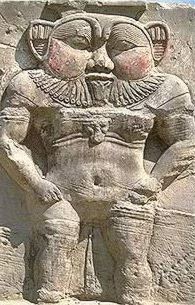Humor in Ancient Egypt
by Jimmy Dunn writing as John Warren

Many people will picture ancient Egypt visually as slaves building the Great Pyramids. It is was comes to one's an the common man's mind's eye, though today we believe that the Pyramids were probably not built primarily with slave labor. Still, the concept does not lend itself easily to smiling, happy faces. In fact there seems to have been little outlet for humor within the confines of official funerary and religious art and literature. Yet we know that ancient Egyptians had a since of humor, even as they toiled to build the ancient monumental buildings. In fact, they even had a god of humor in the form of Bes, who was a fat, bearded dwarf; ugly to the point of being comical.
It is difficult for us to analyze humor even in different modern cultures, much less those of ancient civilizations. Humor and satire are most often associated with the subversion and undermining of normal social decorum, but if the normal social decorum is not fully understood, then the humor or satire will be lost to us.

Most humor comes to us from "unofficial" sources, such as rough sketches and Ostraca, though occasionally we even find official humor, though it most often regards matters outside the Egyptian royal audience. Notable is the scene at the temple of Hatshepsut at Deir el-Bahri that portrays the overweight figure of the queen of Punt, followed by a small donkey. The caption reads, "the donkey that had to carry the queen", and apparently the ordinary Egyptians thought this was funny as well, for they repeated the drawing in rough sketch clearly copied from the original.

In a number of texts, scribes corned just about every other trade (with the exception of their own). Some of this was clearly meant to be humorous, though considering the ego that scribes clearly enjoyed, some of the text were probably out and out scorn. Even in private tombs, there was sometimes mockery of some of the laborers.
Probably the most obvious and one of the largest bodies of humor are sketches and paintings depicting animals such as mice and cats engaged in typical human activities. They are shown beating captives, driving chariots, and in one papyrus, a lion and antelope are shown playing a board game while a cat is shown herding geese. It has been suggested that these might have been illustrations for animal fables, but if this were true, no text has survived as proof.


We are likely to never know the full extent of ancient Egyptian humor. Today we know have considerable knowledge of the royal and religious aspects of ancient Egypt. But while our understanding of common Egyptians is increasing, there is yet much to be learned. It was probably the common Egyptians who formulated most humor, and who probably needed it the most in order to deal with their lives. Today, Egypt remains a society with a great sense of humor.

